Cryptocurrency Information
Coinmama: Cryptocurrency Exchange For How To Buy, Sell & Trade
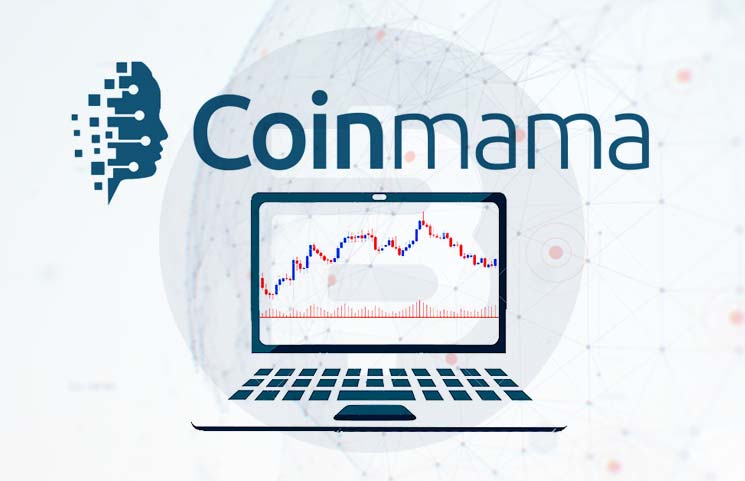
Coinmama is one of the most famous bitcoin marketplaces that sells both Bitcoin and Ethereum to over 1,000,000 verified customers. The exchange provides customers with the opportunity of buying Bitcoin or Ethereum with a credit card. However, the only obstacle that exists for a majority of users willing to use the services offered by this exchange is the unavailability of Visa or Mastercard services in their country of residence.
About Coinmama Crypto Exchange
Table Of Contents
Coinmama.com is a property of NBV International situated in Slovakia, It is a daughter company of New Bit Ventures. New Bit Ventures Ltd is a regulated entity registered as a Money Service Business.
At present, Coinmama is available in 226 countries worldwide, and accepts all local currencies from these countries. The website has been in operation since 2013 and has provided Bitcoin exchange services for a over three years from now. One thing great that users might find about Coinmama is the fact that they accept some of the US states mentioned below:
Arizona, California, Colorado, Florida, Illinois, Indiana, Kansas, Kentucky, Louisiana, Massachusetts Maryland, Michigan, Missouri, Montana, Nevada, New Jersey, New Mexico, North Carolina, Pennsylvania, South Carolina, Tennessee, Texas, Virginia, and Wisconsin.
When compared to other major exchanges, Coinmama is recorded to be from the exchanges that receives the lowest number of monthly visitors, probably due to some restrictions posed by the governments on the use of credit/debit cards, or due to the stringent conditions on the use of cryptocurrencies.
Another of the major causes of this low figure it the fact that users can only buy BTC or ETH from the exchange, no other cryptocurrency can be bought, and option is provided for selling both the BTC and ETH being sold to customers. Another reason could boil down to the fact that, at the time of writing, Coinmama does not have a mobile application which in could enable users to have more access to the exchange. All its services are restricted to be accessible through the web browsers. Also, the exchange does to release a API for users to create custom applications that are compatible with the platform.
Unlike some other exchanges, Coinmama.com does not have a conventional trading platform/interface nor trading tools such as charts. Users can only make simple buy orders, since buying of cryptocurrencies (BTC and ETH) is the only available option.
Another major difference when compared to other exchanges is the fact that Coinmama only supports the use of credit card but doesn’t accept bank wire and SEPA payments. Meaning, users do not have a wider choice of making payments, unlike they do have in other platforms. Also, the exchange charges up to 12% fee per transaction, which is not so inspiring to users.
Coinmama accepts credit & debit cards from all the supported countries around the world, placing no restriction to some users from any over others, unlike some exchange platforms that place restrictions on some countries, even when they claim them to be from the accepted regions.
The exchange is also notable for delivering the buy orders within minutes after the placement of the order without depending on any special order-matching algorithm for processing of orders, allowing users to make the most of advantageous price movements.
As a security measure, Coinmama holds no user funds but sells from its holdings.
The most astounding benefit of Coinmama is the fact that they offer a high daily buying limit of $50,000 for new signups, making the exchange’s limit several times higher than the limit of some of the foremost exchange platforms in the world.
Major Features Of Coinmama Exchange
Security
As stated earlier, to prevent the exchange from being a focus of attack, Coinmama holds no user funds. Instead, the exchange sells bitcoins out of its own inventory. When a customer places an order, the system is designed in such a way that the BTC or ETH bought will be sent directly to the wallet provided to the exchange. Till date, there has never been an incidence of a hack, nor any security breaches on the exchange.
Another security measure employed in protecting the customers is that, Coinmama ensures that customers’ payment details are not stored on the exchange server, should in case the exchange is a targeted for a hack. Also ensures the system ensures that proper encryption of the users’ personal information is done, and stored on dedicated secured servers.
Coinmama Fees
Coinmama charges 5% fee for every credit or debit card deposit with a minimum deposit set at US$10. This charge is in addition to an exchange transaction fee of 6.3%, making Coinmama one of the most expensive exchanges available.
Ease of Use
Coinmama claims to be the Easiest, safest, and the fastest exchange to purchase Bitcoin and Ethereum in the world. The exchange was built with a scalable design, free of uncertainties, and user-friendly interface. It is easy for both newbies and professional traders to interact expediently with the exchange.
Payment methods
At present, Coinmama supports Visa and Master Cards from almost anywhere in the world. When using a credit or debit card, Coinmama accepts payment in either USD or EUR whichever of the two local fiat currencies the buyer prefers. However, the exchange promises to add more local currencies in the future.
Customer support
The exchange has a detailed FAQ section that provides answers to most common questions. The support team also responds to questions on blogs and social media pages. Also, the exchange has a dedicated news and updates section on the main page that gives users an update on the recent events on the platform and the cryptocurrency world in general.
Customers can contact Coinmama’s Customer Care number through +1-800-261-6932 and contact them through their business email at business@coinmama.com. If you need help for account related issues, you can also send them through support@coinmama.com.
Getting Started With Coinmama
The process for buying Bitcoin or Ethereum on Coinmama is pretty straightforward. Like most exchanges, Coinmama requires you to complete identification process to buy BTC or ETH from the exchange. At first, you need to create an account on the website by providing your name, email address, and country of residence. The verification process simply requires you to provide Coinmama with proof that you are exactly who you say you are. You do this by uploading a copy of your passport or driver’s license.
1. Creating an account with Coinmama
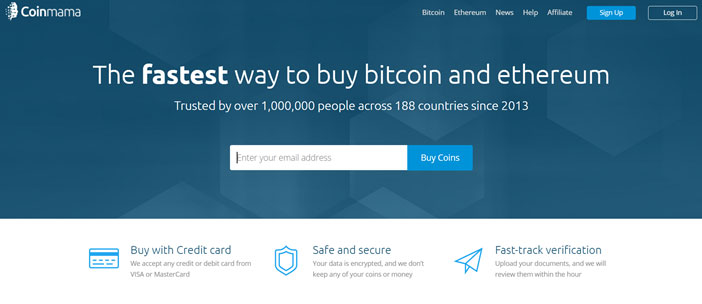
The first step we need to take is to head on to their website www.coinmama.com and click on “Register” which can be found in the upper right corner of the homepage.
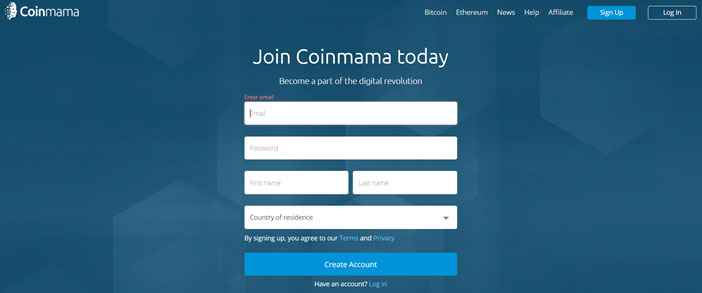
To create an account, you need to provide your email address, a password for the account, your complete name (first, middle, last) and your country of residence. Once all required data has been provided, the next step is to confirm the account.
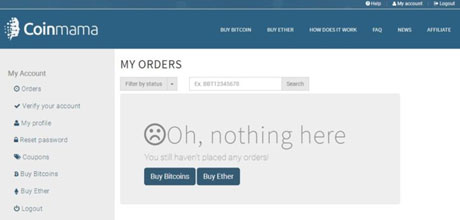
Once an account is created and you have successfully logged into your new Coinmama account, you will see a similar picture as shown above.
This shows your account page and everything that you need to know in regards to purchasing coins from them.
2. Account Verification
Right after your registration, you’ll be given an unverified account. In order to transact and start purchasing Bitcoins or Ethereum, you first need to verify your account.
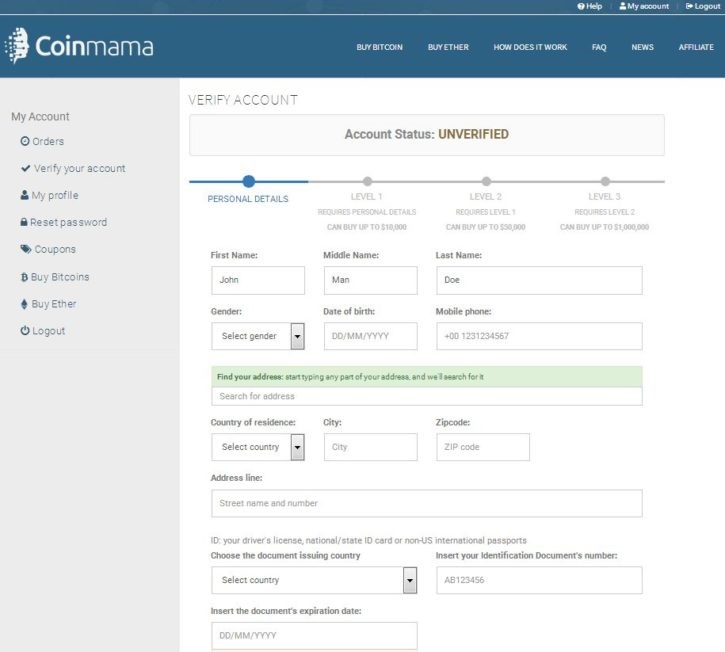
A verified account can be achieved by providing sensitive information to the exchange website. Information needed is your complete address, country of residence, city of residence, and some documents to prove your identity. In general, the more information you provide about your identity, the more level of verification you can attain, and the more you can buy from Coinmama.
Level 1
The maximum limit for level 1 is 10,000 USD. To get your account out from being UNVERIFIED, you only need to provide one government issued ID. Here are the accepted ID’s:
Note: that submitting ID’s means that you need to upload clear pictures of your ID showing the front and back of it.
- Passport
- National ID Card
- Driver’s License
Level 2
The limit for level 2 account is 50,000 USD. In order for an account to reach level 2, you need to get your account to level 1 first. You need to submit an additional ID prior to what you already submitted for level 1 to get your account upgraded to level 2. Accepted ID’s are just the same as the ones mentioned above. Now apart from the mentioned second ID requirement you need to provide the following:
- Utility Bill (Water, Electricity bills) showing your name
- A picture (selfie) of you holding any of the submitted ID’s
Level 3
There is no restriction to the number of trades you can execute with this level. According to Coinmama, level 3 account holders can purchase up to 1 Million US Dollars’ worth of Bitcoin. You can contact the support team on the details of how to upgrade your account to level three if need be.
Making Purchase from Coinmama
To purchase any amount using your credit card you first need to complete your profile. Completing a profile would raise your account limits, which brings us to our next subtitle.
Click on “Buy Bitcoins” and you will be redirected to the purchasing page as shown below:
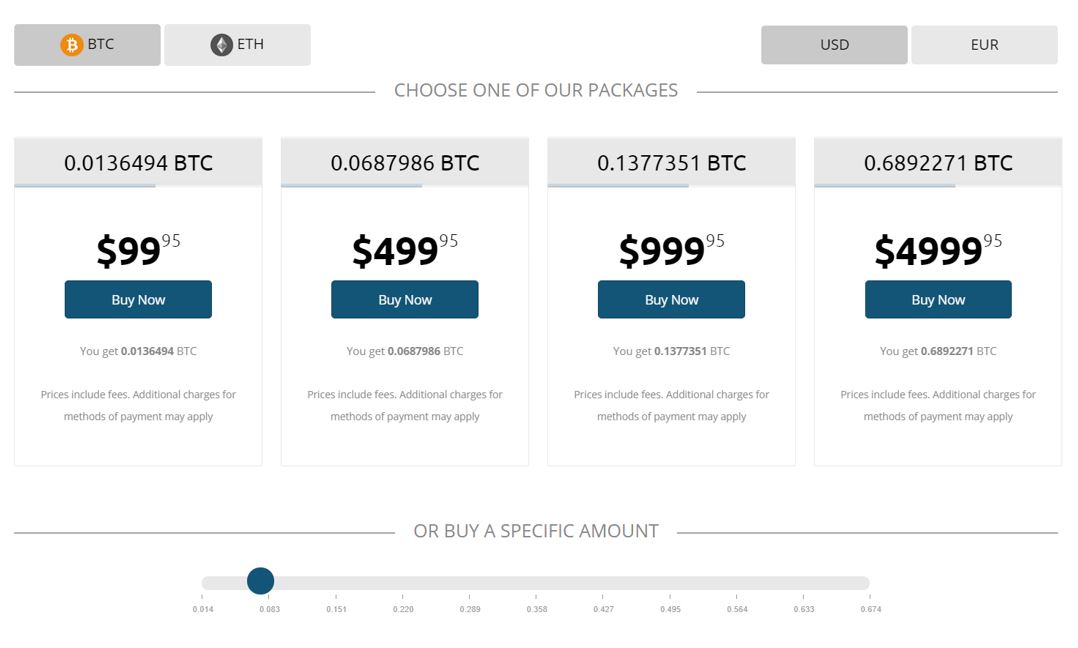
On the purchasing page as shown in the diagram above, choose the amount of Bitcoin or Ethereum you are willing to buy.
Note: There are pre-made packages wherein you just need to click on and get that amount of Bitcoin, or as shown below, you can manually slide the bar which is located below and enter a specific amount needed or depending on the budget you have on hand.

Cryptocurrency Information
Bitcoin Volumes Finally Grow Again and Bitfinex/Tether Issues Spark Systemic Risks, New Diar Report Affirms
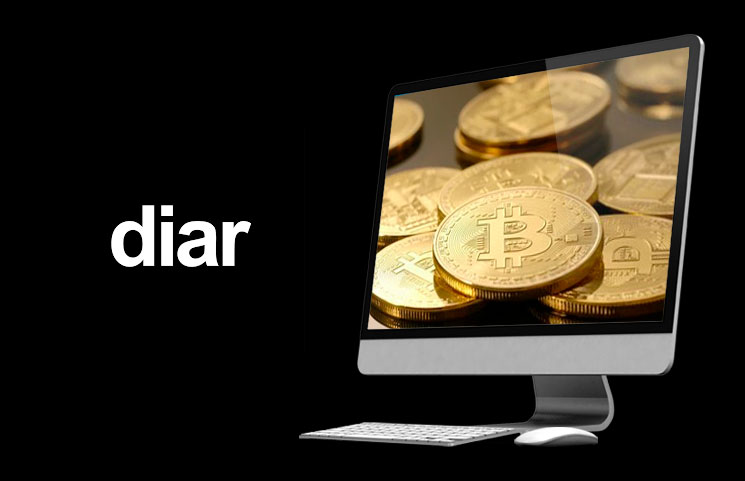
Diar has recently published its report of the crypto market for April. According to the company, Bitcoin volumes are finally growing again and the whole situation with Tether and Bitfinex showed the industry some of its systemic risks. DAI fee hikes and stablecoin projects were also highlighted in the report.
Bitcoin Goes Back To Growing Again
The main highlight of the month is, obviously, that Bitcoin is back on the action. After facing lows which started in 2018, the token has finally been able to effectively reverse the trends and have an actual price surge this month, going from less than $4,200 USD to over $5,200 USD during this short timeframe.
With this, the number of on-chain transactions has spiked for three months in a row, since prices started to get some of their value back in March and April. Now, transaction volumes are around their levels in June 2018 when the price of the asset was around $7,000 USD.
However, charts indicate that Bitcoin is yet to find more footing outside of speculative trading, so the bull market may not be as near as some think.
When looking at the volume of the whole quarters, Q1 2019 had lower volumes than Q4 2018, but Q2 2019 started considerably well.
Bitfinex and Tether Start Concerns of Systemic Risks
As you may have heard, Bitfinex was accused of using Tether funds to cover up its losses. According to Diar, there is a 26% shortfall of in-cash reserves to back Tether tokens (USDT). Tether loaned $850 million USD to Bitfinex to cover up losses and its general counsel Stuart Hoegner has affirmed that the company is operating with fewer reserves than the total market cap of the token.
This happened because Bitfinex had the $850 million USD “seized” by Crypto Capital, one of its payment processors. Unless Hoegner is lying, though, the company had the assets to back the stablecoin until recently.
While it is clear now that Tether simply does not have the money to back the funds, people simply keep buying the tokens. Now, instead of all cash, some shares of Bitfinex are being used to represent the rest of the value, which makes the stablecoin enter securities territory for the first time.
Curiously, the markets are all very tolerant now since the prices are still stable but the systemic risks are clear, especially if other companies are to follow Tether’s path.
DAI Hikes Fees Once More
Another situation highlighted by the reports is that DAI has decided to upgrade its stability fees once again as the community is desperately trying to make the prices of the so-called stablecoin go up again. DAI tokens are being sold for less than $1 USD, their official price, on secondary markets.
At the moment, the fees are 16.5%, after increasing three times in only one month. Before April, the fees were only 7.5%. This has resulted in a decrease of 4.9% in the circulation of DAI tokens.
Stablecoins Eye Wider Use Cases
Gemini and Harbor, a A16Z tokenized securities platform, have started a partnership in order to get more clients for the Harbor stablecoin. However, this was deemed “too soon” by Diar, as Harbor does not have any known token right now. The only one the company had was canceled.
TrustToken is also trying to get more stablecoins on its list, especially the ones that are not focused on USD, but on several other fiat currencies like HKD, CAD or GBP instead.
Cryptocurrency Information
#DropGold Campaign to Hit Your TV, Here’s A Breakdown of the Underlying Bitcoin Message(s)

Grayscale, a leader in digital currency investing, launched an ad on Wednesday, May 1, telling investors that money should be contributed to Bitcoin holdings as opposed to gold. In a number of interviews, CEO of Grayscale’s parent company (Digital Currency Group), Barry Silbert and Managing Director of Grayscale, Michael Sonnenshein, have since expressed the underlying message of the ad.
The #DropGold Ad
According to news outlet, U Today, the ad starts off with a man holding gold bars in his arm, which he decides to drop. While doing so, a woman also does the same. Throughout the ad, people supposedly have their gold bars stacked in shopping carts, while “losing their gold coins.” Watching what’s about to unfold, the two individuals try to find their way out.
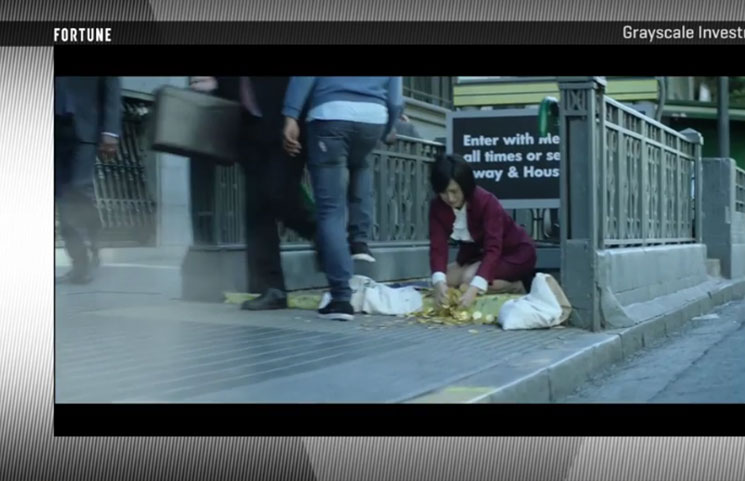
Advertising Bitcoin or Grayscale’s Services?
Despite being the one to have introduced this campaign, Silbert argues that it isn’t entirely about Grayscale services, but rather said services being a result of consumers’ decision. Yahoo Finance has since quoted the following comment made by Silbert himself:
“We do not see this as a Grayscale commercial. For us #DropGold is our ‘Got Milk’. This campaign is first and foremost focused on starting a conversation about bitcoin vs gold. If the ad makes people want to get into Bitcoin, we’re completely indifferent about how they go about doing it.”
Having said this, the commercial is evidently portraying Grayscale as an option, as towards the end, one is told, “Go Digital. Go Grayscale.”
Silbert’s and Sonnenshein’s Arguments Regarding Gold’s Limitations
Silbert believes that this campaign works towards addressing the fact that Bitcoin can serve as an equal asset class as gold, if not better. In particular, he was quoted saying, “But now you have Bitcoin, which, in our opinion, provides all the same attributes as gold – it’s fungible and scarce and you can’t counterfeit it – but the big difference is that Bitcoin has utility. Gold doesn’t have much utility beyond jewelry.”
He further argued that the goal here isn’t to replace fiat currency for shopping purposes, but rather to show the world that Bitcoin does a better job at doing gold’s job and this will be evident in the long run. Although he has acknowledged Bitcoin’s volatility as being concerning, he is hopeful that it will one day serve as both an ideal utility token and store of value.
As for Sonnenshein’s viewpoint, he sees this ad as revealing the “absurdity” associated with gold. More specifically, he said:
“We’re going after a narrative around gold being where investors should go when markets turn south or as a hedge against inflation […] we’re highlighting the absurdity of gold.”
As per The Block Crypto, Grayscale also tries to convince investors that the return earned from redistributing 5% of gold to Bitcoin will be greater than 5% yearly.
What are your overall thoughts on this ad? Did it leave you asking yourself, “Why did you invest in gold? Are you living in the past?” Share your thoughts below!
Cryptocurrency Information
Huobi Pro Bitcoin Exchange: Cryptocurrency Asset Trading Platform?
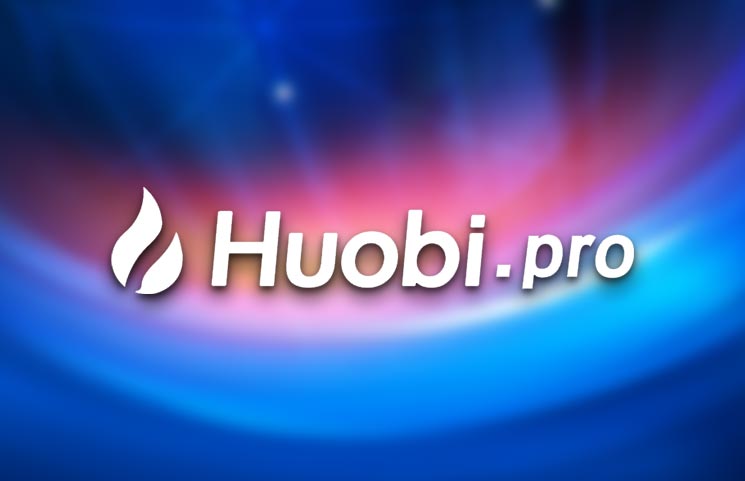
Huobi Pro Cryptocurrency Exchange
Founded in 2013, Huobi Pro allows for a myriad digital currencies to be exchanged, at a 0.2 percent trading commission. Loyal users point to the low fees and stellar service that make the exchange stand out above others.
Although pitched at dedicated cryptocurrency enthusiasts since the site doesn’t accept fiat currencies many who enter the realm on the back of fiat end up at Huobi Pro, largely due to its diverse offering and favorable fee structure.
Huobi Pro in A Nutshell

A victim of China’s clampdown on digital currencies, the company might be registered in the Seychelles, but was originally founded in Beijing. As testament to the broad appeal of the platform, after the Chinese regime effectively banned all things crypto at the beginning of 2018, trading volumes have only grown.
While at first very much a Chinese company looking at the home market, Huobi Pro has been forced to find a wider marketplace on the international scene. Indeed, even prior to the official cessation of altcoins and their trading, the company heard the rumblings in 2017 and took its cryptocurrency interests abroad.
Huobi now provides exchange services to users in over 130 countries. Company offices are located in the USA, Korea, Japan, Singapore and Hong Kong. Although the Huobi Group also owns and manages the Huobi Autonomous Digital Asset Exchange (HADAX), Huobi Pro is more of a pure “login and trade” exchange.
Users can employ network tokens to cast votes on adding new altcoins on HADAX. On the Huobi Pro exchange, a simplified offer encompassing all of the mainstream altcoins greets visitors. Some more popular coins offered are Bitcoin (BTC), Bitcoin Cash (BCH), Ethereum (ETH), Litecoin (LTC), NEM (XEM), NEO (NEO), Qtum (QTUM) and Ripple (XRP).
That said, when one actually tallies the number of altcoins available for exchange, it becomes apparent why loyal followers value the site. A marriage of both simple ease of use and diversity in trading, the platform is largely welcomed by newcomers and experienced enthusiasts alike. In the current melee of regulation being contemplated, implemented and tweaked all the while, some users may be precluded from trading on the exchange based on their country of residence.
Huobi Pro accepts the funding of accounts only in digital currencies, and accepts deposits in any of its listed altcoins. Unlike other exchanges that have opted for a midway between crypto and fiat, Huobi Pro traders deal strictly in digital coins at every point of a transaction. Funds need to be withdrawn to a wallet, and fiat users looking to buy in will have to establish a wallet first in order to fund their Huobi Pro trading account.
Traders pay a maker or taker fee of just 0.02 percent using the exchange. There are more detailed offers, worth looking at for daily traders with volume.
Huobi Pro Membership Levels
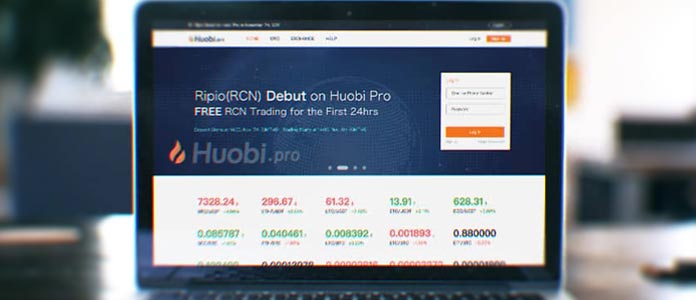
VIP users get preferential platform trading fees if they buy the privilege with Huobi tokens. The Huobi Token (HT) was never an ICO token, but rather a system token that users only obtain by buying “Point Cards” on the Huobi Pro platform. Point Card is essentially a pre-paid Huobi card that keeps users liquid on service fees. One HT = 1 USD, therefore one “point” = 1 USD. The more points purchased, the more free points are added, although savings on 1000 points, for example, means only 10 HT for free.
Huobi Global minted a fixed total of 500 million tokens, with 300 million employed to facilitate the in-house VIP structure. A mark of the business group behind the platform is seen in their practice of buying back-sold tokens from the open market each quarter. Not only that, but those funds go towards the Huobi Investor Protection Fund (HIPF).
This is a planned fund that will compensate investors who suffer platform disruption and subsequent losses. It’s a tool that minimizes risk, smooths out the market overall and also goes towards protecting investor interests. This transparent and pleasing aspect of the platform is one reason traders have confidence in the exchange, and its popularity is rising worldwide.
By way of example, in order to glean a VIP status, a trader will pay 120 HT a month for First Level membership. This enables a 20 percent discount on trading fees. Running through toward the top end, a pricier option of 6,000 HT a month secures a 50 percent discount on fees. Overall, a diligent trader can optimize the system and come out with a substantial discount on the already low 0.02 percent base offer.
The company charges no fees to deposit funds, but there are withdrawal fees. Although there are reviews online listing withdrawal fees, it appears that, especially within the membership structure, users are advised to ascertain exact fees when establishing their account. Likewise, transfer limits need to established upfront to avoid disappointment later. There exist order size limits on the platform too, again becoming more malleable as one moves up the ranks of the VIPs.
Security And UX On Huobi Pro

All of the standard protocols including two-step Google Authenticator verification are at play on the platform. Unlike many other exchanges that offer a simple crypto-exclusive platform, Huobi Pro will need your personal details in the form of a passport copy and chat room comments are not devoid of complaints, although almost all of them take issue with the structure of the platform and its potential pitfalls. There are few allegations of lost funds or other negligence on behalf of the company. On the whole, Huobi Pro seems to be rubbing off its decidedly corporate ethos onto the exchange – good news for traders overall.
Another serious boon for the cryptosphere as a whole is that over 98 percent of holdings are stored in an offline cold wallet or vault. Imbued with a strict customer service ethic, the platform probably sports the best customer service to date for crypto exchanges. Available 24/7 365, there is a live chat option onsite.
The platform intel is sufficient although newbies might have to scratch to paint a clear picture of how exactly everything works. The FAQs are thoughtful and, again, testament to a polished offering. Huobi used to be one of the biggest Chinese crypto exchanges, based in Beijing. Started by entrepreneur Leon Li in 2013, since the move there has been mutual appreciation of its value. Worldwide users have taken to the exchange, as it too realized that it had global appeal.
Huobi Pro Conclusion

Huobi claims to have exceeded BTC 500,000 in daily trading approaching 2014. Although only in its fifth year, that’s a long time in cryptocurrency. Although frequently accused of embellishing trading volumes, these allegations have never been proven. In comparison to other digital exchanges that have suffered persistent user complaints and even been shut down due to criminal activity, Huobi Pro shines.
As an offering, it has low fees, great diversity and an unbeatable crypto-energy. No trader on the platform feels like they’re missing out on something else somewhere else, by most accounts. Possibly due to their prior involvement in the fintech world, the platform got it right first time around and user numbers prove it. The company Huobi also owns another trading platform, BitYes, more focused on USD/BTC and USD/LTC pairs trading. Great customer service and minimal technical glitches have made it appear positively top-tier, again in comparison to less polished outfits.
With a detailed offering, great client liaison – very unusual for most digital exchanges so far – and no legitimate proof of anything even vaguely dark hanging about them, the Huobi Pro project is recommended. Users are advised to always ascertain costs prior to trading – not hard with the customer support in this case – and sample a platform with small trades before trading greater amounts. To learn more, you can head to their official website: huobi.pro










